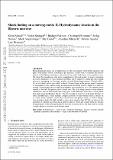| dc.contributor.author | Schaal, Kevin | |
| dc.contributor.author | Springel, Volker | |
| dc.contributor.author | Pakmor, Rüdiger | |
| dc.contributor.author | Pfrommer, Christoph | |
| dc.contributor.author | Nelson, Dylan | |
| dc.contributor.author | Vogelsberger, Mark | |
| dc.contributor.author | Genel, Shy | |
| dc.contributor.author | Pillepich, Annalisa | |
| dc.contributor.author | Sijacki, Debora | |
| dc.contributor.author | Hernquist, Lars | |
| dc.date.accessioned | 2017-05-01T18:20:03Z | |
| dc.date.available | 2017-05-01T18:20:03Z | |
| dc.date.issued | 2016-07 | |
| dc.date.submitted | 2016-06 | |
| dc.identifier.issn | 0035-8711 | |
| dc.identifier.issn | 1365-2966 | |
| dc.identifier.uri | http://hdl.handle.net/1721.1/108546 | |
| dc.description.abstract | Hydrodynamical shocks are a manifestation of the non-linearity of the Euler equations and play a fundamental role in cosmological gas dynamics. In this work, we identify and analyse shocks in the Illustris simulation, and contrast the results with those of non-radiative runs. We show that simulations with more comprehensive physical models of galaxy formation pose new challenges for shock finding algorithms due to radiative cooling and star-forming processes, prompting us to develop a number of methodology improvements. We find in Illustris a total shock surface area which is about 1.4 times larger at the present epoch compared to non-radiative runs, and an energy dissipation rate at shocks which is higher by a factor of around 7. Remarkably, shocks with Mach numbers above and below
M≈10
contribute about equally to the total dissipation across cosmic time. This is in sharp contrast to non-radiative simulations, and we demonstrate that a large part of the difference arises due to strong black hole radio-mode feedback in Illustris. We also provide an overview of the large diversity of shock morphologies, which includes complex networks of halo-internal shocks, shocks on to cosmic sheets, feedback shocks due to black holes and galactic winds, as well as ubiquitous accretion shocks. In high-redshift systems more massive than 10¹² M⊙, we discover the existence of a double accretion shock pattern in haloes. They are created when gas streams along filaments without being shocked at the outer accretion shock, but then forms a second, roughly spherical accretion shock further inside. | en_US |
| dc.language.iso | en_US | |
| dc.publisher | Oxford University Press | en_US |
| dc.relation.isversionof | http://dx.doi.org/10.1093/mnras/stw1587 | en_US |
| dc.rights | Creative Commons Attribution-Noncommercial-Share Alike | en_US |
| dc.rights.uri | http://creativecommons.org/licenses/by-nc-sa/4.0/ | en_US |
| dc.source | arXiv | en_US |
| dc.title | Shock finding on a moving-mesh – II. Hydrodynamic shocks in the Illustris universe | en_US |
| dc.type | Article | en_US |
| dc.identifier.citation | Schaal, Kevin; Springel, Volker; Pakmor, Rüdiger; Pfrommer, Christoph; Nelson, Dylan; Vogelsberger, Mark; Genel, Shy; Pillepich, Annalisa; Sijacki, Debora and Hernquist, Lars. “Shock Finding on a Moving-Mesh – II. Hydrodynamic Shocks in the Illustris Universe.” Monthly Notices of the Royal Astronomical Society 461, no. 4 (July 2016): 4441–4465. | en_US |
| dc.contributor.department | Massachusetts Institute of Technology. Department of Physics | en_US |
| dc.contributor.department | MIT Kavli Institute for Astrophysics and Space Research | en_US |
| dc.contributor.mitauthor | Vogelsberger, Mark | |
| dc.relation.journal | Monthly Notices of the Royal Astronomical Society | en_US |
| dc.eprint.version | Author's final manuscript | en_US |
| dc.type.uri | http://purl.org/eprint/type/JournalArticle | en_US |
| eprint.status | http://purl.org/eprint/status/PeerReviewed | en_US |
| dspace.orderedauthors | Schaal, Kevin; Springel, Volker; Pakmor, Rüdiger; Pfrommer, Christoph; Nelson, Dylan; Vogelsberger, Mark; Genel, Shy; Pillepich, Annalisa; Sijacki, Debora; Hernquist, Lars | en_US |
| dspace.embargo.terms | N | en_US |
| dc.identifier.orcid | https://orcid.org/0000-0001-8593-7692 | |
| mit.license | OPEN_ACCESS_POLICY | en_US |
